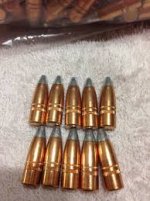The multiple cannelures will be for accommodation by different chamberings, some of which have throats closer to the case neck than others.
As already advised, see what length your chamber will allow. To use standard load data, seat the bullet about 0.030" deeper than that maximum length to avoid proximity to the lands raising pressure (can raise it about 20%).
Note that sometimes you can't easily push a bullet into a fired case because the case mouth is curled slightly inward. You can either expand that or slit the neck part way down its length with a Dremel tool or a hacksaw. Whether the fired case curl interferes or not depends partly on how wide the chamber neck is. After you set a bullet barely into the case, push it into the chamber with your finger until the case stops against its shoulder. I recommend you then gently push the case and bullet out from the muzzle with a cleaning rod. This avoids the bullet pulling out slightly, as can happen if you extract the case normally. If your neck is tight in the chamber it could come out too short, but it can't come out too long, which is what can make trouble. Measure the result. If you haven't done this before, do it several times to see how much your numbers vary and to be sure you didn't get a short reading because the bullet caught on the corner of the throat.
Once you have the maximum length, you can decide whether a cannelure is close enough to be of interest to you or not. It is usually only required to use one with a crimp for ammunition that is to be handled very roughly (lots of dropping). Occasionally it helps improve start pressure consistency to improve accuracy, so you don't want to reject it out of hand, either. Mostly its just another thing you can try. I've never found it necessary.
The other thing you have to discover is if the new maximum length still fits in a magazine or not. That's the main reason for the SAAMI standard maximum COL: magazine fit and feeding. Match shooters for long range normally load singly, so they don't care if it fits in the magazine or not, and as a result, often seat longer to have a little more powder space or because the longer bullet position proves to provide better accuracy.

